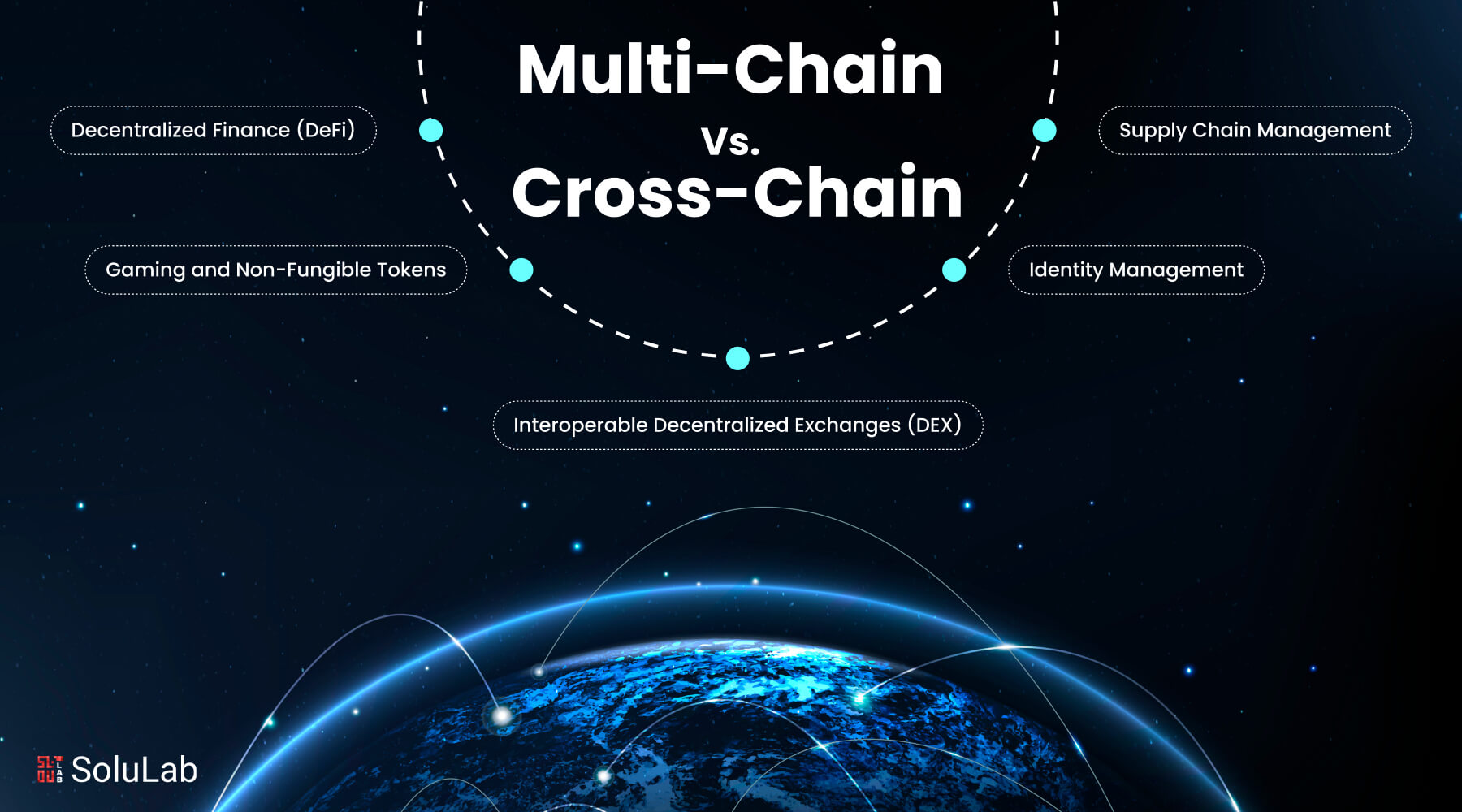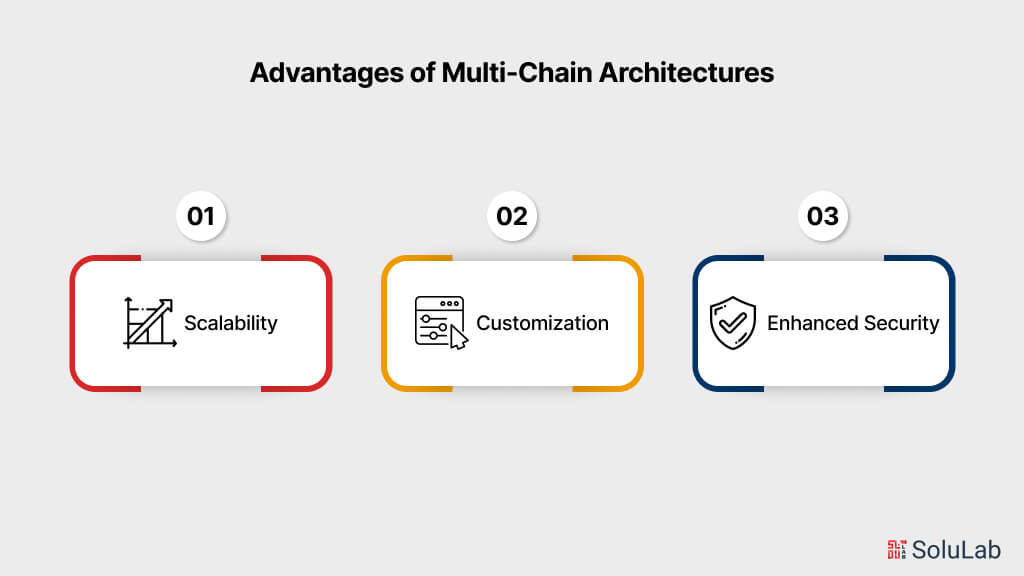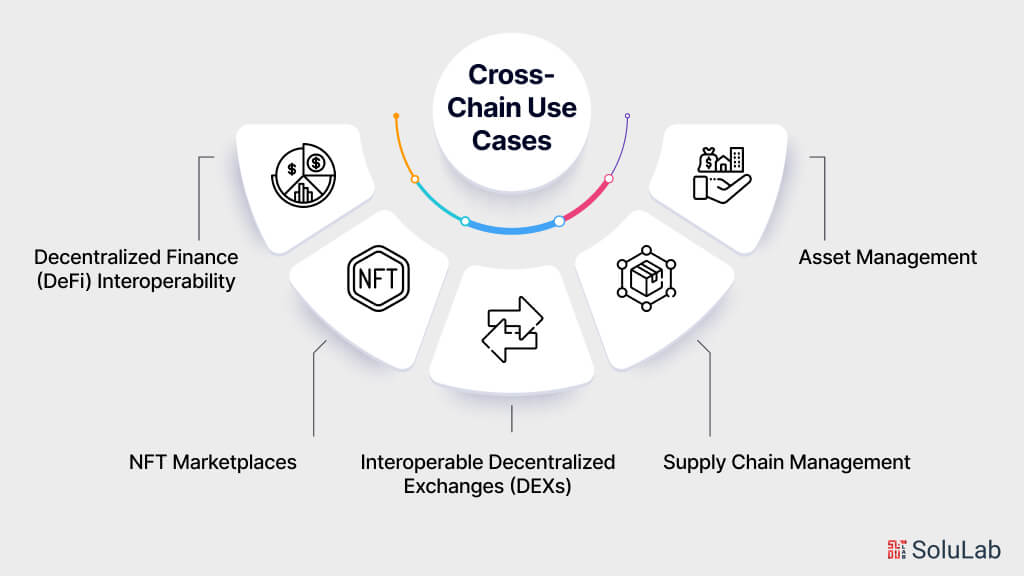
Blockchain technology is a game-changer, providing decentralized solutions to several sectors and companies. Fundamentally, blockchain is a distributed ledger technology that facilitates safe, open transactions without the need for middlemen. Blockchain has come a long way since its introduction with Bitcoin in 2009, and a plethora of platforms and apps have emerged to take use of its special qualities.
Although the terms “multi-chain” and “cross-chain” are frequently used synonymously in the cryptocurrency community, they have different connotations and applications. While value and information are transferred between several blockchain networks in both models, their methods and goals are distinct.
In this blog, we will go over the important use cases, advantages, limitations, and differences between cross-chain and multi-chain crypto.
Importance of Interoperability in Blockchain Networks
As blockchain technology continues to proliferate, the need for interoperability between different blockchain networks becomes increasingly critical. Interoperability refers to the ability of different blockchain platforms to communicate and transact with each other seamlessly. Without interoperability, blockchain ecosystems risk becoming fragmented, hindering the potential of decentralized applications (DApps) and limiting their adoption.
Interoperability enables various blockchain networks to share data, assets, and functionalities, unlocking new possibilities for innovation and collaboration. It facilitates cross-border transactions, enables asset interoperability, and fosters the creation of interconnected ecosystems. Moreover, interoperability promotes competition and diversity within the blockchain space, driving further innovation and development.
What is Multi-Chain?
Multichain is a kind of blockchain technology that occurs when several chains link to one another in a federated setting. Federated chains maintain the independence of each individual network while enabling permissioned access between designated entities. Participants on a chain must agree on a set of standards before they may transact with each other. This configuration allows for the safe upkeep of private data stores, with each network managing its consensus method on its own.
Each Decentralized Application (DApp) instance in a multi-chain ecosystem has smart contracts that are separate from apps running on various blockchains. New on-chain settings raise overall aggregate throughput as the multi-chain ecosystem develops, drawing more users with less transaction costs. In this context, scalability, decentralization, method design, consensus, execution, data availability, and privacy are all approached differently by each network.
Advantages of Multi-Chain Architectures

Before delving into specific advantages, it’s important to recognize that multi-chain architectures offer a range of benefits that address key challenges within blockchain ecosystems. These advantages include scalability enhancements, customization capabilities, and heightened security measures, all contributing to the overall efficiency and effectiveness of blockchain networks.
1. Scalability
Multi-chain architectures offer a solution to the scalability limitations commonly associated with single-chain blockchain networks. By employing multiple parallel chains, each capable of processing transactions independently, multi-chain platforms can significantly increase throughput and transaction throughput. This multi-chain scalability enhancement allows for the handling of a larger volume of transactions without compromising network performance or transaction speed. Additionally, multi-chain architectures can dynamically allocate resources to different chains based on demand, further optimizing scalability and resource utilization.
2. Customization
One of the key advantages of multi-chain architectures is the ability to tailor each chain to specific use cases or requirements. Unlike single-chain platforms where all transactions are processed on a single ledger with uniform rules, multi-chain architectures enable developers to create specialized chains optimized for different applications. This customization allows for greater flexibility in designing blockchain solutions that meet the diverse needs of various industries and use cases. Developers can implement different consensus mechanisms, smart contract languages, and governance models on individual chains, optimizing performance and functionality for specific applications.
3. Enhanced Security
Multi-chain architectures can enhance security by isolating transactions and smart contracts into separate chains, reducing the potential impact of security breaches or vulnerabilities. In a multi-chain environment, if one chain is compromised, it does not necessarily affect the security of other chains within the network. Furthermore, multi-chain platforms can implement advanced security features such as sharding, encryption, and multi-signature authentication across multiple chains, providing robust protection against unauthorized access, tampering, and fraud. By distributing transactions and data across multiple chains, multi-chain architectures can mitigate the risk of a single point of failure and enhance overall network resilience.
Examples of Multi-Chain Platforms
Before exploring examples, it’s notable that several prominent platforms have embraced multi-chain architectures to revolutionize blockchain functionality.
- Ethereum 2.0: Ethereum 2.0, also known as Ethereum 2 or Eth2, is a major upgrade to the Ethereum blockchain aimed at improving scalability, security, and sustainability. One of the key features of Ethereum 2.0 is the introduction of a multi-chain architecture called the Ethereum Beacon Chain. This beacon chain serves as the backbone of the Ethereum 2.0 network, coordinating the activities of multiple shard chains. Shard chains are individual chains that process transactions in parallel, enabling Ethereum 2.0 to achieve higher throughput and scalability compared to the original Ethereum blockchain.
- Polkadot: Polkadot is a multi-chain blockchain platform designed to facilitate interoperability between different blockchains. It employs a multi-chain architecture consisting of multiple parallel chains called para chains, which are connected to a central relay chain. Parachains can be customized to support specific use cases or applications, while the relay chain provides a secure and decentralized communication layer between parachains. Polkadot’s multi-chain architecture enables crosschain messaging, asset transfers, and interoperability, allowing diverse blockchains to interact and share data seamlessly.
- Cosmos: Cosmos is a decentralized network of interconnected blockchains designed to enable interoperability and scalability across disparate blockchain platforms. At the core of the Cosmos ecosystem is the Cosmos Hub, a multi-chain blockchain that serves as a hub for connecting various independent blockchains, called zones. Each zone in the Cosmos network operates independently with its own set of validators, consensus mechanisms, and governance structures. Through the Inter-Blockchain Communication (IBC) protocol, Cosmos enables secure and trustless communication between different zones, facilitating asset transfers and data exchange across multiple blockchains.
Multi-Chain Applications
Multi-chain architectures open up a wide array of applications across various industries, using their scalability, customization, and enhanced security features. Here are some notable multi-chain applications:
1. Decentralized Finance (DeFi)
Multi-chain platforms are revolutionizing the DeFi by offering scalable solutions for financial services. With customized chains catering to specific financial products such as lending, borrowing, and decentralized exchanges (DEXs), users can access a wide range of DeFi applications with improved efficiency and reduced transaction costs. Ethereum 2.0, Polkadot, and Cosmos are facilitating the growth of DeFi by providing scalable infrastructures for decentralized financial protocols.
2. Supply Chain Management
Multi-chain architectures are transforming supply chain management by enhancing transparency, traceability, and efficiency. Customized chains enable stakeholders to track products throughout the supply chain, ensuring authenticity and reducing the risk of fraud or counterfeit goods. By integrating blockchain technology with Internet of Things (IoT) devices and smart contracts, multi-chain platforms facilitate real-time monitoring and automated execution of supply chain processes.
3. Gaming and Non-Fungible Tokens (NFTs)
Multi-chain platforms are powering the burgeoning market for gaming and NFTs by providing scalable infrastructures for digital asset management and trading. Customized chains enable developers to create immersive gaming experiences with tokenized assets and in-game economies. Additionally, interoperability between chains allows for seamless crosschain asset transfers and trading, enhancing liquidity and accessibility for NFT enthusiasts.
Related: NFTs in Gaming
4. Identity Management
Multi-chain architectures offer secure and decentralized solutions for identity management, enabling individuals to control their personal data and digital identities. Customized chains support the creation of self-sovereign identity systems, where users can securely store and manage their identity credentials on the blockchain. By utilizing advanced cryptographic techniques and multi-chain interoperability, identity management applications enhance privacy, security, and user control over personal data.
5. Government and Public Services
Multi-chain platforms are reshaping government and public services by providing transparent and efficient solutions for data management and governance. Customized chains enable governments to digitize administrative processes, streamline public service delivery, and enhance transparency and accountability. By implementing blockchain technology, multi-chain applications improve data integrity, reduce bureaucracy, and empower citizens with greater control over their interactions with government agencies.
What is Cross-Chain?
Cross-chain is a type of blockchain technology that allows for the smooth transfer of assets and data between various networks by allowing numerous chains to link in an interoperable manner. This architecture enables the creation of smart contracts, safe transactions across several chains, and Decentralized Applications (Dapps)—all without depending on a central authority or middleman.
Native cross-chain apps may be developed thanks to the capabilities of cross-chain technology. Under this model, a single Decentralized Application (dApp) instance runs smoothly across many smart contracts that are installed on separate blockchains, as opposed to setting up several separate instances on different networks.
In a cross-chain technology, several smart contracts on various chains each carry out discrete tasks while staying synchronized, all working together to support a single use case inside a single application. This methodology enables developers to use the unique benefits provided by various blockchain networks.
Advantages of Cross-Chain Architectures
Cross-chain architectures play a pivotal role in addressing the interoperability challenges inherent in blockchain ecosystems, offering a multitude of advantages that enhance connectivity, liquidity, and accessibility. Here are some key advantages:
1. Interoperability
Cross-chain architectures enable seamless communication and interaction between disparate blockchain networks, fostering interoperability and collaboration. By facilitating the transfer of assets and data across different chains, crosschain solutions break down silos and create interconnected ecosystems, expanding the reach and utility of blockchain technology.
2. Increased Liquidity
Cross-chain architectures enhance liquidity by enabling asset transfers and trading across multiple blockchains. Through interoperability protocols such as atomic swaps and decentralized exchanges (DEXs), users can seamlessly exchange assets between different chains without the need for intermediaries or centralized exchanges. This interoperability promotes market efficiency, price discovery, and liquidity provision, benefiting traders, investors, and DeFi participants.
3. Enhanced Security
Cross-chain architectures improve security by using the decentralized and immutable nature of blockchain technology. By enabling trustless asset transfers and cross-chain transactions, cross-chain solutions mitigate counterparty risk and reduce the reliance on centralized intermediaries. Additionally, cryptographic techniques such as hash locks and multi-signature schemes ensure the integrity and authenticity of cross-chain transactions, enhancing overall security and trust in the ecosystem.
Related: Layer-1 Vs. Layer-2: The Blockchain Scaling Solutions
4. Diversification and Risk Mitigation
Cross-chain architectures offer diversification opportunities for blockchain users, allowing them to access a broader range of assets and applications across different chains. By spreading risk across multiple blockchains, users can mitigate the impact of potential vulnerabilities or failures in any single network. Moreover, cross-chain interoperability reduces dependency on any single blockchain platform, promoting resilience and stability within the broader blockchain ecosystem.
5. Scalability and Performance
Cross-chain architectures enhance scalability and performance by offloading transactions and computational tasks to multiple chains. By distributing workload across interconnected networks, cross-chain solutions alleviate congestion and bottlenecks, improving overall throughput and efficiency. This scalability enhancement enables blockchain networks to handle a larger volume of transactions and support growing user demand without sacrificing performance or increasing transaction costs.
Examples of Cross-Chain Solutions
Cross-chain solutions are at the forefront of driving interoperability between disparate blockchain networks, offering innovative approaches to facilitate asset transfers, data exchange, and cross-chain transactions. Here are some notable examples:
- Atomic Swaps: Atomic swaps enable peer-to-peer exchange of cryptocurrencies across different blockchains without the need for intermediaries. This trustless and decentralized mechanism allows users to swap assets atomically, ensuring that either both parties receive the agreed-upon assets or the transaction is canceled. Atomic swaps use smart contracts and cryptographic hash functions to facilitate secure and verifiable cross-chain transactions, enabling seamless asset transfers between compatible blockchains.
- Interoperability Protocols: Interoperability protocols such as the Interledger Protocol (ILP) and the Blockchain Interoperability Protocol (BIP) facilitate communication and data exchange between different blockchain networks. These protocols establish standards and guidelines for interoperability, enabling seamless integration and interoperability between disparate systems. By defining common data formats, messaging protocols, and communication channels, interoperability protocols enable cross-chain transactions, asset transfers, and smart contract interoperability, promoting connectivity and collaboration within the blockchain ecosystem.
- Decentralized Oracles: Decentralized oracles serve as trusted sources of external data and information for blockchain applications, enabling smart contracts to interact with off-chain data and systems. By utilizing decentralized consensus mechanisms and cryptographic proofs, decentralized oracles provide reliable and tamper-proof data feeds for cross-chain applications. Decentralized oracles enable blockchain networks to access real-world data, such as price feeds, weather information, and IoT sensor data, facilitating cross-chain interoperability and enabling new use cases in decentralized finance (DeFi), supply chain management, and decentralized autonomous organizations (DAOs).
- Cross-Chain Bridges: Cross-chain bridges are specialized protocols or smart contracts that facilitate asset transfers and interoperability between different blockchain networks. These bridges establish secure connections between blockchains, enabling the seamless transfer of assets and data across disparate systems. Cross-chain bridges often utilize token wrapping or token locking mechanisms to facilitate cross-chain transfers, ensuring that assets remain securely locked on one chain while corresponding tokens are minted or unlocked on another chain. By bridging multiple blockchain networks, cross-chain bridges enable cross-chain liquidity provision, decentralized asset exchanges, and cross-chain DeFi applications.
- Cross-Chain Middleware: Cross-chain middleware platforms such as Chainlink and Wanchain provide infrastructure and tools for building cross-chain applications and interoperable blockchain networks. These middleware platforms offer a suite of services, including cross-chain data oracles, interoperability protocols, and cross-chain asset management tools, enabling developers to create and deploy cross-chain applications with ease. By abstracting the complexities of cross-chain interoperability, middleware platforms empower developers to focus on building innovative applications and solutions that utilize the full potential of blockchain technology.
Cross-Chain Use Cases

Cross-chain solutions have facilitated a myriad of innovative applications across various industries, tapping into interoperability to unlock new opportunities for collaboration, efficiency, and value creation. Here are some notable cross-chain use cases:
1. Decentralized Finance (DeFi) Interoperability
Cross-chain interoperability is reshaping decentralized finance (DeFi), allowing seamless asset transfers and liquidity provision across multiple blockchain networks. Platforms like Polkadot and Cosmos enable cross-chain asset exchanges, granting users access to a diverse range of DeFi protocols and liquidity pools across different chains. This enhances market efficiency, liquidity provision, and composability within the DeFi ecosystem, empowering users with greater financial service access and opportunities.
2. Interoperable Decentralized Exchanges (DEXs)
Cross-chain DEXs capitalize on interoperability protocols and cross-chain bridges to facilitate decentralized asset trading across different blockchain networks. Platforms like Thorchain and Uniswap v3 enable trustless and non-custodial trading of assets across disparate chains, facilitating seamless cryptocurrency exchange without centralized intermediaries. Cross-chain DEXs enhance liquidity, price discovery, and accessibility for traders, investors, and DeFi participants, fostering a more decentralized and inclusive financial ecosystem.
3. Cross-Chain Asset Management
Cross-chain asset management platforms empower users to manage and diversify their cryptocurrency portfolios across multiple blockchain networks. Platforms like Enjin and ICON facilitate seamless transfer and management of tokenized assets across different chains, providing users with greater flexibility and control over their investments. These solutions enhance portfolio diversification, risk management, and asset liquidity, allowing users to optimize their investment strategies and mitigate risk in the dynamic cryptocurrency market.
4. Cross-Chain NFT Marketplaces
Cross-chain NFT marketplaces use interoperability protocols and cross-chain bridges to enable trading and ownership of non-fungible tokens (NFTs) across different blockchain networks. Platforms like Rarible and OpenSea facilitate the creation, discovery, and exchange of NFTs across disparate chains, enabling artists, creators, and collectors to access a global marketplace for digital assets. NFT marketplace platforms enhance liquidity, discoverability, and interoperability for NFTs, driving innovation and creativity in the digital art and collectibles space.
5. Cross-Chain Supply Chain Management
Cross-chain solutions are revolutionizing supply chain management by enabling seamless data exchange and asset tracking across multiple blockchain networks. Platforms like VeChain and IBM Food Trust use cross-chain interoperability to enhance transparency, traceability, and efficiency in supply chains, enabling stakeholders to track products from source to destination across disparate chains. These solutions enhance supply chain visibility, compliance, and sustainability, allowing organizations to optimize operations and build trust with consumers.
Related: Business Lens on Blockchain Stack: From Layer 0 to Layer 3
Differences Between Multi-Chain Vs. Cross-Chain
Multi-chain and cross-chain are two approaches to interoperability in blockchain technology, but they have distinct differences:
| Aspect | Multi-Chain | Cross-Chain |
| Scope | Multiple independent blockchains within the same ecosystem | Facilitates communication between separate blockchain networks |
| Independence | Each blockchain operates independently | Facilitates communication between separate blockchains |
| Interoperability | Interaction between chains within the same ecosystem | Communication and asset transfer between distinct blockchains |
| Use Cases | Scalability, customization, and isolation of functionalities | Decentralized exchanges, asset tokenization, cross-border payments |
| Challenges | Security, scalability, and governance across multiple chains | Security, scalability, standardization of cross-chain protocols |
Future of Multi-Chain vs. Cross-Chain in Blockchain Technology
As blockchain technology continues to evolve, the future of both multi-chain and cross-chain approaches holds significant promise, albeit with distinct trajectories and applications.
1. Multi-Chain
The future of multi-chain ecosystems is likely to see further proliferation and specialization. As blockchain networks become more complex and diverse, the need for tailored solutions catering to specific use cases will grow. Multi-chain architectures offer flexibility and scalability, allowing developers to design blockchains optimized for particular applications such as decentralized finance (DeFi), non-fungible tokens (NFTs), supply chain management, and more.
In the future, we can anticipate the emergence of interconnected multi-chain ecosystems, where interoperability between different chains within the same framework becomes more seamless. This could lead to the development of standardized protocols and interoperability frameworks, enabling easier communication and asset transfer between diverse blockchain networks.
Moreover, advancements in consensus mechanisms, scalability solutions, and governance models will further enhance the viability and efficiency of multi-chain architectures. Projects exploring novel approaches to cross-chain communication within multi-chain ecosystems are likely to gain traction, fostering innovation and collaboration across various blockchain platforms.
2. Cross-Chain
Cross-chain technology is poised to play a pivotal role in addressing the interoperability challenges faced by the blockchain industry. As the number of blockchain networks continues to grow, the ability to transfer assets and data seamlessly between disparate chains will become increasingly crucial.
In the future, cross-chain solutions are expected to become more sophisticated and standardized, enabling frictionless interoperability between a wide range of blockchain networks. This could lead to the development of interoperability protocols and middleware layers that facilitate secure and trustless cross-chain transactions. Furthermore, cross-chain interoperability has the potential to unlock new use cases and applications that use the strengths of multiple blockchain platforms. Decentralized finance (DeFi), decentralized exchanges (DEXs), asset tokenization, and cross-border payments are just a few examples of areas where cross-chain technology can revolutionize the way value is exchanged and managed.
As the blockchain ecosystem matures, cross-chain interoperability standards are likely to become more widely adopted, fostering greater collaboration and synergy between different blockchain projects and communities. This could ultimately pave the way for a more interconnected and inclusive blockchain technology, where innovation and creativity thrive across diverse networks and applications.
In conclusion, both multi-chain and cross-chain approaches have promising futures in blockchain technology, each addressing distinct needs and challenges. While multi-chain architectures offer flexibility and scalability within a single ecosystem, cross-chain interoperability enables seamless communication and asset transfer between separate blockchain networks. As these technologies continue to evolve, they will play key roles in shaping the future of decentralized finance, digital asset management, and beyond.
Concluding Thoughts
In conclusion, the future of blockchain technology is intricately tied to the evolution of both multi-chain and cross-chain approaches. While multi-chain architectures offer versatility and scalability within individual ecosystems, cross-chain interoperability holds the key to seamless communication and asset transfer between disparate blockchain networks. As the blockchain industry continues to mature, the convergence of these two approaches will likely drive innovation and unlock new possibilities for decentralized applications, financial systems, and beyond. Whether it’s optimizing specific use cases within a multi-chain framework or enabling cross-chain interoperability for broader connectivity, the advancements in both areas will shape the decentralized technology for years to come.
At SoluLab, we understand the importance of staying ahead in the blockchain ecosystem. As a leading blockchain development company, we offer expertise in both multi-chain and cross-chain technologies, empowering businesses to utilize the full potential of blockchain innovation. Whether you’re looking to build custom blockchain solutions, integrate cross-chain interoperability, or hire blockchain developers for your project, SoluLab provides tailored services to meet your unique needs. Contact us today to start your blockchain journey and unlock new possibilities for your business.
FAQs
1. What is multi-chain technology, and how does it differ from cross-chain interoperability?
Multi-chain technology involves the creation of multiple independent blockchains within the same ecosystem, each serving specific purposes or applications. In contrast, cross-chain interoperability focuses on facilitating communication and asset transfer between separate blockchain networks that operate independently.
2. What are the benefits of using multi-chain architectures in blockchain development?
Multi-chain architectures offer scalability, customization, and isolation of functionalities within a single ecosystem. They allow for tailored solutions optimized for specific use cases, such as decentralized finance (DeFi), gaming, supply chain management, and enterprise solutions.
3. How does cross-chain interoperability enhance blockchain ecosystems?
Cross-chain interoperability enables seamless communication and asset transfer between different blockchain networks, unlocking new possibilities for decentralized applications, financial systems, and beyond. It fosters collaboration and synergy between disparate blockchain projects and communities, driving innovation and connectivity in the decentralized technology.
4. What are some real-world applications of multi-chain and cross-chain technologies?
Multi-chain architectures are utilized in various applications, including decentralized finance (DeFi) platforms, non-fungible token (NFT) marketplaces, supply chain management systems, and enterprise blockchain solutions. Cross-chain interoperability facilitates decentralized exchanges (DEXs), asset tokenization, cross-border payments, and interoperable blockchain platforms.
5. How can businesses use multi-chain and cross-chain solutions for their blockchain projects?
Businesses can use multi-chain architectures to create tailored blockchain solutions that meet specific requirements and use cases. They can also explore cross-chain interoperability to enable seamless communication and asset transfer between different blockchain networks, enhancing connectivity and functionality within their ecosystems.






